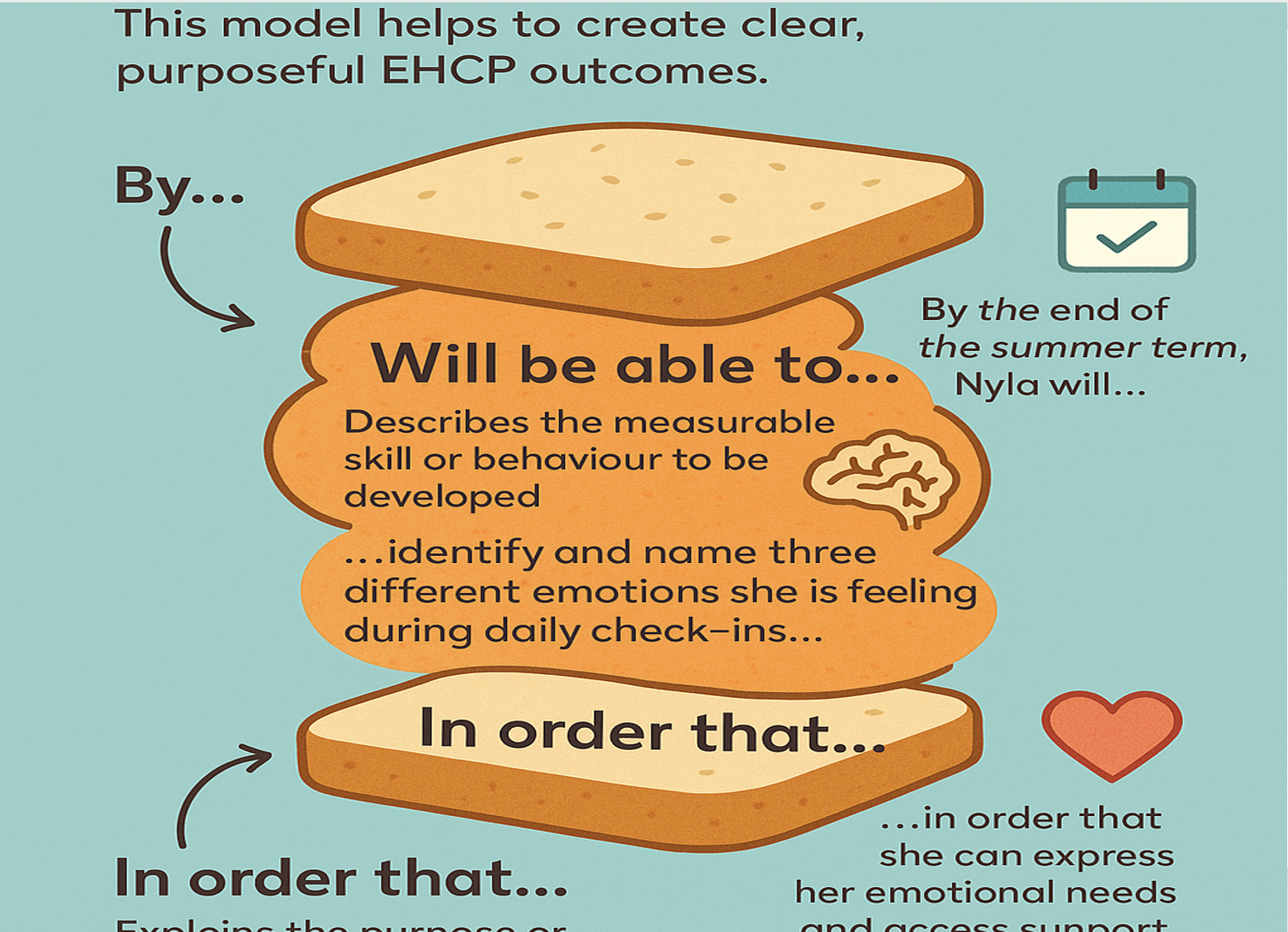Impact-driven outcomes: Writing SEND outcomes that transform lives & track progress

Impact-driven outcomes: Writing SEND outcomes that transform lives & track progress
A comprehensive guide to the key frameworks covered in our recent webinar - your handy reference for developing effective SEND outcomes
Introduction
Creating meaningful outcomes for children and young people with SEND is at the heart of effective practice. Our recent webinar brought together leading experts to share proven frameworks and practical approaches that truly make a difference. This guide summarises the key insights and frameworks covered, providing you with a comprehensive reference tool for your daily practice.
The expert panel
Our webinar featured three distinguished professionals sharing their expertise:
- Rachael Wilcox - Designated Professional SEND Manager, NHS England
- Carole Lewis - SEND and Inclusion Consultant
- Freyr Bendleton - SENCO, Safeguarding Lead and Former SEND Information, Advice and Support Service Manager
Framework 1: NHS England's SEND quality improvement framework
The Foundation: quality improvement vs quality assurance
Quality improvement focuses on making services safe, effective and person-centred, leading to measurable improvements in care and better outcomes for children and young people.
Quality assurance is the process of measuring against quality standards and expectations to determine fitness for purpose (such as QA of EHCPs or clinical pathways).
The eight key principles
The co-produced SEND quality improvement framework centres on eight fundamental principles that define what 'good' quality looks and feels like:
- Person-centred approach - Services designed around the individual
- Co-production - Meaningful involvement of families and young people
- Timely access - Services available when needed
- Coordinated care - Seamless working across agencies
- Effective communication - Clear, consistent information sharing
- Skilled workforce - Competent, confident professionals
- Continuous improvement - Learning and adapting based on feedback
- Outcome focused - Measuring what matters to families
Key implementation insights
- The framework was developed through extensive consultation with parents, carers, children and young people
- A planning and evaluation tool supports outcome statements to demonstrate real impact
- The focus is on articulating impact that is meaningful to families, not just service providers
- Early implementation showed challenges with language and formatting changes from traditional improvement plans
Access the framework: The complete SEND Quality Improvement Framework and tool is available through the Council for Disabled Children website.
Framework 2: The graduated approach to effective outcomes
Assessment of needs - The foundation
Effective outcomes start with comprehensive assessment using three types:
- Formative assessment - Ongoing evaluation to inform teaching and support
- Summative assessment - End-point evaluation of learning and progress
- Diagnostic assessment - Pre-assessment to identify prior knowledge and areas for development
The power of collaborative practice
Research consistently shows that multi-agency collaboration significantly improves outcomes:
Educational benefits:
- Better engagement and achievement
- Improved mental and physical health outcomes
- Greater independence and life skills development
- Smoother transitions into adulthood and employment
- Reduced risk of exclusion
Key success factors:
- Dedicated key workers enhance coordination
- Strong relationships between schools and external professionals
- Pupil-centred, collaborative approaches lead to more accurate needs identification
Team Around the Child (TAC) Model
When to use TAC:
- Complex needs requiring multiple service input
- Early intervention before EHCP consideration
- Supporting key transitions
Key Features:
- Multi-agency collaboration with the child and family at the centre
- Shared goals and outcomes
- Regular review meetings
- Development of a 'My Support Plan'
Benefits:
- Reduces duplication and gaps in support
- Builds trust between families and professionals
- Ensures timely, consistent and effective support
Framework 3: The outcome sandwich structure

The three essential components
This practical framework ensures outcomes are comprehensive and meaningful:
Top slice: "By..." (Timeline)
- Realistic timescale aligned with review periods
- Includes the child's name for personalisation
- Should align with term endings, academic years, or key stages
Filling: "Will be able to..." (Observable skill)
- Specific skill or behaviour the child will develop
- Must be measurable through observation or assessment
- Directly linked to provision in Section F of the EHCP
Bottom slice: "So that..." (Purpose and impact)
- Explains how this development helps the child move toward their aspirations
- Connects to real-life function and independence
- Links to Preparation for Adulthood where appropriate
Practical example
Primary need: Social, Emotional and Mental Health (SEMH)
Aspiration: Nyla wants to feel calmer in school and be able to talk to adults when upset
Outcome: "By the end of the summer term, Nyla will identify and name three different emotions during daily check-ins, so that she can express her emotional needs and access support before becoming overwhelmed."
Framework 4: The golden thread approach
Connecting all elements
The golden thread ensures coherence throughout the EHCP:
- Section A - Child's views, interests and aspirations
- Section B - Special educational needs identified
- Section E - Outcomes that address the needs
- Section F - Provision to achieve the outcomes
Long-term vs short-term outcomes
Long-term outcomes:
- Reviewed annually as part of the EHCP review
- Should be ambitious yet achievable
- Connect to Preparation for Adulthood themes
Short-term outcomes:
- Reviewed termly or half-termly
- Support progress toward long-term goals
- Inform day-to-day teaching and support strategies
Case study: Ella's journey
Primary need: Cognition and Learning
Aspiration: To become an author or illustrator
Long-term outcome: "By the end of Key Stage 2, Ella will independently use assistive technology to plan, write, and revise written tasks of up to 300 words, in order to fully participate in literacy-based lessons and demonstrate her learning effectively."
Short-term outcome: "By the end of Term 1, Ella will use predictive text tools to complete a 100-word writing task with adult support, in order to develop confidence using assistive technology."
Framework 5: SMART outcomes with impact
Beyond basic SMART criteria
While outcomes must be SMART (Specific, Measurable, Achievable, Realistic, Time-bound), they must also be:
- Personal - Not expressed from a service perspective
- Meaningful - Something those involved have control and influence over
- Impactful - Focused on what the child wants to achieve
- Aspirational - Building toward independence and future goals
The voice of the child
Meaningful participation requires moving beyond tokenism to genuine shared decision-making:
Levels of participation:
- Child/Young Person initiated and directed
- Adult initiated, shared decisions with CYP
- CYP consulted and informed
- CYP assigned and informed
- Tokenism (avoid)
- Decoration (avoid)
- Manipulation (avoid)
Quality outcome examples
Effective outcomes:
- "Will be able to recognise how he feels and express this appropriately"
- "Will report finding something enjoyable or having succeeded at something in school every day"
- "Will be able to work with a small group of peers and listen to their ideas and opinions even if different from his"
Implementation guidelines
For SEND professionals
- Start with aspirations - Always begin with what the child wants to achieve
- Use the frameworks - Apply the Outcome Sandwich and Golden Thread approaches systematically
- Collaborate effectively - Implement Team Around the Child principles
- Review regularly - Use both formative and summative assessment approaches
- Measure impact - Focus on outcomes that matter to families, not just services
For annual reviews
Annual reviews are key opportunities to:
- Meaningfully involve children and young people in understanding their EHCP
- Build shared understanding about support and its purpose
- Assess progress toward both long-term and short-term outcomes
- Determine if outcomes remain appropriate and ambitious
- Adjust provision to better meet identified needs
Quality assurance considerations
When reviewing outcomes, consider:
- Are they written from the child's perspective?
- Do they connect clearly to identified needs?
- Are they ambitious yet achievable?
- Do they link to appropriate provision?
- Will progress be measurable?
- Do they contribute to long-term aspirations?
Key takeaways
- Frameworks provide structure but the child's voice and aspirations must remain central
- Collaboration across agencies consistently improves outcomes for children and young people
- Quality improvement focuses on meaningful impact for families, not just service metrics
- Regular review and adjustment ensures outcomes remain relevant and ambitious
- Practical tools like the Outcome Sandwich make complex processes more manageable
Resources and further support
- SEND quality improvement framework - Available through Council for Disabled Children
- SEND Code of Practice 2015 - Statutory guidance on outcomes (paragraphs 9.64-9.69)
- Supporting SEND Research Report 2021 - Evidence on collaborative approaches
- Ofsted & CQC Joint SEND Inspection Framework 2023 - Current inspection priorities
This guide summarises the key frameworks from our webinar on impact-driven SEND outcomes. Keep it handy as a reference tool for developing outcomes that truly transform lives and effectively track progress.
Full access to the webinar recording is available on our YouTube channel and presentation slides can be viewed here.
Ensure you're signed up for webinar notifications so you're first to know about our next webinar in September on EHCP templates - exploring a national / regional template.
About Invision360: With over 20 years of experience in the LA SEND sector, Invision360 provides award-winning quality assurance software and AI-powered EHCP drafting modules to 60+ local authorities nationally. Our passion is improving outcomes for children and young people through smarter, faster, and completely secure solutions.





Please sign in or register for FREE
If you are a registered user on SEND Network, please sign in